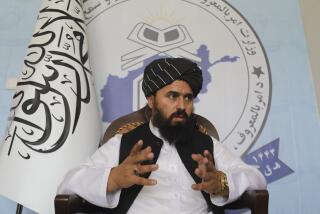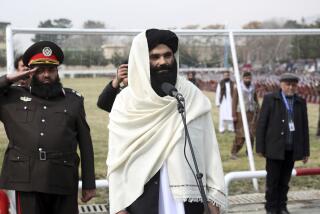Little Appears Uniform for Taliban Foes
TAPPAH SURQH, Afghanistan â The crisp new fatigues were a bit big for Zikr Ullahâs gangly body, so he had to pull the web belt in all the way to the last notch. A friend tried to smooth out the straight-from-the-box creases at the back but gave up.
The Iranian-made uniform was one of thousands that the anti-Taliban Northern Alliance has been handing out over the past few days to soldiers who have spent years fighting in whatever they happened to be wearing.
Ullah, 18, picked up his uniform, wrapped in cellophane, at the allianceâs 2nd Division headquarters on this barren hillside overlooking the Shomali plain. Not long after at least three U.S. bombs exploded in the distance, Ullah was asked what difference a new uniform would make in the war against the Taliban.
âNone,â Ullah said, and he carried on struggling with his belt.
As pressure builds in the region for a quick end to the U.S. airstrikes against the Taliban, Americaâs Afghan allies in the war against terrorism donât give the appearance of being strong enough to take the lead in the fighting any time soon. They are short on training, weapons and ammunition, and they lack a unified central command.
But if the soldiers arenât quite an army, at least they are trying to look like one.
âTrainingâ in Front of Invited Audience
The alliance invited reporters to watch what it said was training by about 500 2nd Division soldiers Tuesday morning on this base littered with the rusting carcasses of Soviet-era tanks and other weapons.
Soldiers picked up new uniforms from cartons marked âWorker Suitsâ in English above this sentence in Persian: âThese uniforms are for soldiers only.â The seven box loads were enough to outfit 140 soldiers, but there werenât enough belts or boots for all of them, said Abdul Hafiz, a commander who recorded the distribution on a scrap of paper.
The message of Tuesdayâs photo opportunity was supposed to be that the Northern Alliance is not a ragtag lot anymore, but it got lost in the translation. The few hundred soldiers on display included a gray-haired man with one eye who was carrying an empty rocket-propelled grenade launcher. A teenage soldier farther down the hill had a rocket-propelled grenade but no launcher.
The training consisted of standing almost at attention in parade formation, but the soldiers couldnât make a straight line. And after the cameras moved on, the soldiers sat around on the ground chatting and looking bored.
Taliban forces donât wear uniforms, and they donât do photo opportunities. But after more than three weeks of bombing, many are proving to be determined fighters motivated by an often fanatical zeal to be martyred in what they consider a jihad, or holy war, against infidel invaders.
But as the Northern Alliance holds the line on the front north of Kabul, the capital, and regroups for another try at seizing the strategic northern city of Mazar-i-Sharif, it doesnât appear to be fighting with urgency.
Some military experts suspect that the alliance is holding fire, hoping that it can squeeze promises from Washington of more power in a post-Taliban government. Or it may simply be sitting and waiting for a victory it could never hope to achieve without overwhelming U.S. air power and support from foreign ground troops.
The Pentagon has confirmed that small units of U.S. troops are working alongside Northern Alliance forces, and aircraft are dropping desperately needed ammunition to Afghan forces planning an offensive on Mazar-i-Sharif.
The Bush administration, and perhaps its chief ally in London, is realizing that the war in Afghanistan âwill have to play outâ longer than it expected, Steven Simon, associate director of the International Institute for Strategic Studies, said from London.
âThere may be a growing sense in Washington that Kabul will have to be delivered on a silver platter [to the Northern Alliance],â he added, referring to any effort to take the capital. âThat will be done, to the extent possible, using air power.â
The history of modern war suggests that soldiers can hold out under intense airstrikes if they arenât coming under attack by ground troops too, Simon added.
âExtensive studies of the use of air power for interdiction have indicated that you can bomb quite heavily but [that] if the force that youâre bombing isnât being chewed up at the same time on the ground, they can actually withstand bombing for a very long time,â he said.
Little Sign of Any Advance on Kabul
The Northern Alliance constantly threatens to launch an attack to surround Kabul and then send in what it calls special police units to restore law and order in the capital while a new government takes shape. But so far, firing across the front lines north of Kabul appears largely aimless.
U.S. bombing along the Kabul front was some of the heaviest yet Tuesday, but the Northern Alliance continues to say that it isnât heavy enough. With that kind of complaint coming almost daily, itâs beginning to sound like nothing less than the obliteration of Taliban lines will be enough to get the opposition to attack on the ground.
But it is also possible that Washington wants the Northern Alliance to hold off on an offensive until there is a political agreement for a post-Taliban government under exiled former King Mohammad Zaher Shah. Progress on that front also appears stalled.
âWhat we donât know is whether the Northern Alliance is just listening to those American advisors and doing what they tell them or whether there is a lot of negotiating going on,â Chris Aaron, editor of Janeâs Intelligence Review, said from London.
âWhatâs very hard to determine is whether it is truly this political issue,â Aaron said, âor whether the bombing is well worked out with a strategy of chasing various elements of the Taliban--particularly the foreign cadres--forcing them into the open and picking them off.â
U.S. May Increase Presence in Area
The Pentagon says it is looking at the possibility of setting up a small base in the Northern Alliance-controlled Panjshir Valley, where a few hundred U.S. soldiers could provide medical and logistical support to special forces making helicopter-borne assaults.
U.S. Special Forces are also often used to train small groups of foreign troops in guerrilla-style tactics, but Simon said he âwouldnât normally think of the words âeliteâ and âNorthern Allianceâ in the same sentence.â
The Northern Alliance suffers from being a collection of regional and local commanders, little more than warlords, who cooperate only when it suits them. In the 1990s, fighting among some of their regimeâs commanders and rival warlords blasted large parts of Kabul to ruins and killed tens of thousands of people.
When the Taliban seized Kabul from President Burhanuddin Rabbaniâs troops in 1996, many Afghans welcomed the Taliban as liberators, only to suffer under its increasingly hard-line Islamic rule.
Pressure is mounting in the Muslim world for a halt to the bombing as the Muslim holy month of Ramadan approaches in mid-November.
Observers say the Taliban may be hoping that if the regime can hold out long enough, the bombing will stop and its troops will get a huge morale boost in advance of any ground offensive by Northern Alliance forces supported by U.S. and British soldiers.
But Aaron said he believes that the precise and often massive explosions from U.S. weapons are making Taliban soldiers suffer as they never did when fighting the Northern Alliance before, or Soviet troops before them.
âThey may be getting battle-hardened, but they are also getting killed,â Aaron said. âThe bombs that are going off arenât just raising loads of dust, even if the Taliban are not showing pictures of dead soldiers.â
More to Read
Sign up for Essential California
The most important California stories and recommendations in your inbox every morning.
You may occasionally receive promotional content from the Los Angeles Times.










